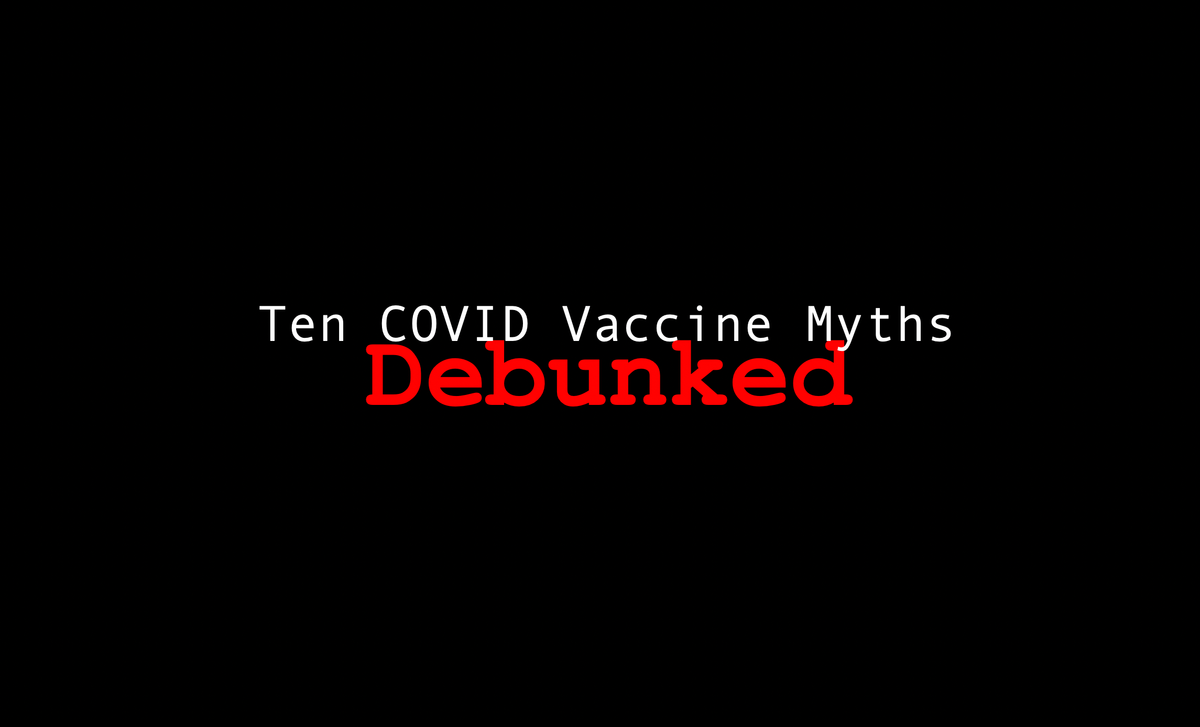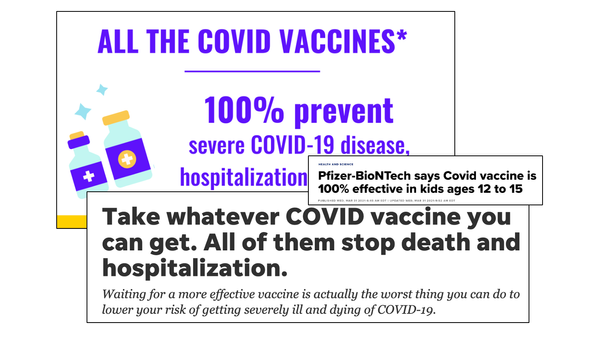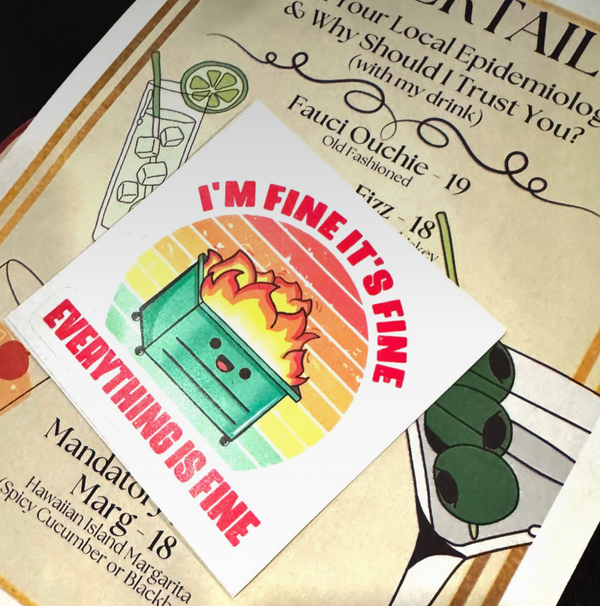Ten COVID mRNA Vaccine Myths Debunked

Here are some of the most common myths I’ve seen circulating online about the mRNA vaccines, and why they don’t hold up. Please share with those trying to sort vaccine fact from fiction.
Myth #1: The COVID mRNA vaccines aren't actually vaccines, they are experimental gene therapy.
A vaccine is a substance that stimulates an immune response, providing immunity against a pathogen. The COVID vaccines do that; they are vaccines. They are also not ‘experimental.’ That term is used to describe vaccines or therapeutics that are currently being studied in clinical trials. Once the clinical trials have been completed, as they have been for the mRNA vaccines, they are no longer ‘experimental.’ The experiment (the trial) has been done, and we know the results. They are also not gene therapy in the sense that they do not alter human DNA, and their purpose is not to replace a faulty human gene, which is what we usually think of when we say ‘gene therapy.’
Myth #2: The COVID mRNA vaccines aren't vaccines because they don't prevent people from getting infected and they don't prevent transmission.
The COVID vaccines do prevent symptomatic infection very, very well. That is what the clinical trials showed. The issue of transmission is a little more complex – the trials didn’t specifically study if the vaccines prevent transmission, they only studied if the vaccines prevented symptomatic infection. So the trials didn’t give us any data on whether or not they prevent transmission, and we couldn’t say one way or the other. That being said, the fact that they prevent symptomatic infection makes many scientists very hopeful that they will prevent transmission, and there is now data coming out to support this. What’s definitely false is to say that we know the vaccines *don’t* prevent transmission. That’s not true.
Update: since writing this article, more studies have come out looking at asymptomatic infection after vaccination, and guess what?! They significantly reduce asymptomatic infection too.
Myth #3: There are no data supporting the safety and efficacy of the vaccines.
False. Both mRNA vaccines have completed stage 1, 2, and 3 clinical trials, which is the standard set of clinical trials for safety and efficacy testing of any vaccine or therapeutic. Here is the data for the Pfizer vaccine, here is the data for the Moderna vaccine.
Here is a much easier way to understand the data (this is for the Pfizer vaccine specifically):
Myth #4: VAERS reports show that lots of people have been having serious reactions and dying from the vaccines.
False. The Vaccine Adverse Events Reporting System (VAERS) is a system that allows anyone to input any event that is temporally related to the vaccine, but may or may not actually be connected to the vaccine. They are not confirmed reports, anyone can log in and file something. Someone could die in a car accident driving home from getting the vaccine, and that could be entered as a report as ‘temporally related to the vaccine.’ But clearly, vaccines do not cause car accidents. You can’t just read the reports and assume everything in there was truly caused by the vaccines. That doesn’t work — it takes analysis of the VAERS data compared to background levels of those events to determine if there is a causal link with the vaccine. The CDC has done this, and has found that majority of the VAERS reports are mild side effects like fatigue and headache. They also analyzed the deaths and compared it to the expected rate of death in the population, and have not found any results to suggests deaths are causally related to the vaccine.
Myth #5: The COVID mRNA vaccines contain aluminum, mercury, and heavy metals.
No they don’t. The ingredients are:
1. The mRNA
2. Lipids (types of fat), including polyethylene glycol (PEG)
3. Salts (containing ions that are naturally found in the body)
4. Tromethamine (commonly used to maintain pH balance, Moderna vaccine only)
5. Sucrose (sugar)
Here are the sources for Pfizer and Moderna vaccine ingredients.
Myth #6: The mRNA vaccines contain aborted fetuses.
False. Vaccines do not contain aborted fetuses. Some vaccines do use what are called fetal cell lines. This is not the same thing as fetal tissue. Fetal cell lines are cells that were derived from a sample taken from a single aborted fetus decades ago, and a few of the cells have been artificially replicating in a lab since then. Cell lines like this are common in science for all sorts of tissue types, not just fetal cells (adult kidney cell lines, adult lung cell lines, etc.) When you hear about ‘in vitro’ studies or testing drugs in a dish, they often use cell lines like these. Some vaccines use fetal cell lines to produce the vaccine (for live attenuated virus vaccines), but the fetal cell lines are not included in the final vaccine preparation. There are never any fetal cells in any vaccines. Furthermore, as the mRNA vaccines are not live attenuated virus vaccines, fetal cell lines are NOT used to produce the mRNA vaccines. Sometimes fetal cell lines are used in one or more of the experiments in the lengthy development process of vaccines, but not in the final vaccine production step. The mRNA vaccines did use fetal cell lines in one of the research steps. You can read more about that here. It’s important to note that the use of fetal cell lines is not specific to vaccine research, as these cell lines are widely used in many areas of medical research.
Myth #7: The PEG used in the mRNA vaccines is highly toxic and dangerous.
False. PEG, which stands for polyethylene glycol, is a type of lipid (fat) that is used to coat the mRNA vaccines, as well as other therapeutics. It is also commonly used as a laxative (miralax). PEG does seem to cause anaphylaxis very, very rarely. Remember that things like peanuts can cause anaphylaxis as well, yet we don’t label them as ‘toxins’ or start campaigning against peanut butter. If peanut butter could prevent COVID, I don’t think anyone would be labeling it as highly toxic or dangerous, but of course we would not give it to people who had a peanut allergy. Same thing goes for the vaccines — the risk of anaphylaxis is very, very low for the general population, but of course we’re going to be careful with people who have a known allergy.
Here is a published review of cases of anaphylaxis after COVID vaccination. They found the chance of anaphylaxis was 5 in a million for the Pfizer vaccine, and 2.5 in a million for the Moderna vaccine. While anaphylaxis is certainly serious, it is also readily treatable with epinephrine, and nobody died from the anaphylactic reaction.
Myth #8: The mRNA vaccines will make women sterile.
False. This was based on the rumor that there was similarity between the COVID spike protein used in the vaccines and a protein in the placenta. But they aren’t similar. There is no issue. I wrote a whole blog post about this one, check it out here.
Myth #9: The COVID mRNA vaccine side effects are as bad as getting COVID.
False. The COVID mRNA vaccines can cause mild side effects like fever, chills, and malaise shortly after getting the vaccine. These are usually mild and last only a day or two. I experienced these side effects after my second dose; it was about the intensity of a mild cold, and only lasted about 8 hours. While this is slightly worse than the side effects of other vaccines like the flu shot, it is nowhere near as bad as getting COVID. Even when people don’t have to be hospitalized, COVID infection can make people sick for weeks. I’ve heard it described as ‘the sickest I’ve ever been in my life.’ And for some, they never fully recover. Some people have not been able to taste food for months. And, of course, COVID can kill people. So the side effects from the vaccine, while slightly annoying, are nothing compared to COVID.
Myth #10: If I get the vaccine and I have a rare reaction, it will be my fault, but if I decline vaccination and then get COVID, it's not my fault.
I think this logical flaw trips up a lot of people when weighing the risks and benefits of vaccines. No vaccine (or any drug, for that matter) is 100% without side effects, and so you always have to weigh the risk of the side effects against the risk of the disease the vaccine is protecting against. In the case of the COVID vaccines, the risk of serious side effects are minuscule, and the risk of serious complications from COVID are substantial. So the math clearly favors getting the vaccine. But one thing that can throw people off is many people feel like they’ll be more ‘responsible’ if they have a rare side effect from the vaccine (because they made an active decision to get vaccinated), but will feel less ‘responsible’ if they get COVID after declining vaccination, since that’s based on a passive decision not to get the vaccine. So don’t let this logical flaw trip you up. If you don’t get the vaccine, you’re at way higher risk for getting COVID. If a person has the opportunity to prevent something from happening and they choose not to, they are still responsible for the outcome of that decision.




